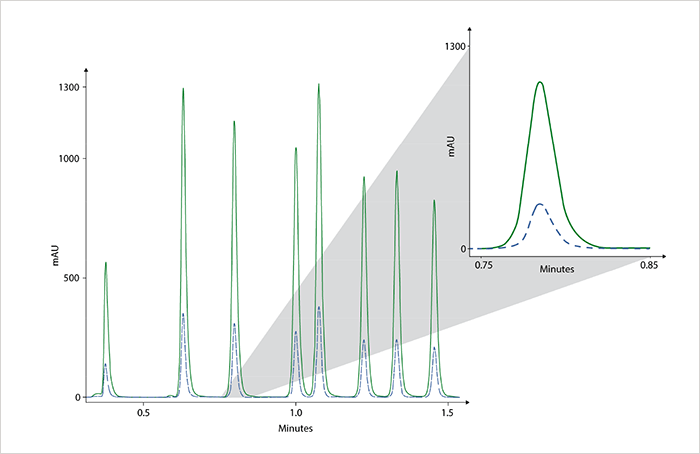Summary
KNAUER has been manufacturing world-class HPLC instruments for the past five decades. One of our key competencies is the development of robust and highly sensitive diode array detectors (DAD). The latest device to come to market is the AZURA DAD 2.1L, characterized by an optimized optical bench, active temperature control and a wide range of flow cells covering numerous application fields. With the aid of a cartridge adapter, remote flow cells can be installed on this diode array detector via fiber optic cables. Fiber optic flow cells can be decoupled from the detector and mounted, for instance, directly onto the column outlet. This eliminates the delay volume between column outlet and detector. Other remote flow cell applications include detection in high temperature and hazardous environments.

Introduction
KNAUER has recently released a new member of the AZURA HPLC product line: the AZURA DAD 2.1L, a highly competitive diode array detector with 8 detection channels covering a wavelength range of 190 – 700 nm. A wide range of easily exchangeable flow cells make the AZURA DAD 2.1L ideal for fast, standard analytical, semi-preparative, preparative and biopurification tasks. The AZURA DAD 2.1L can be controlled with OpenLab® EZChrom and ClarityChrom® software, as well as from an optional touch display (AZURA Mobile Control), via LAN or analog input/output, allowing it to be integrated into almost any LC system.
Application Range
Flow Cell Cartridges State-of-the-art total reflection flow cells (LightGuide technology) in cartridge design are available for the AZURA DAD 2.1L. These flow cells provide maximum light throughput (due to total internal reflection) with minimal peak dispersion (due to the small cell volume) to guarantee an optimized signal to noise (S/N) ratio.
 Fig. 1: Chromatographic separation carried out with standard LightGuide flow cell (blue, dashed) vs. high sensitivity LightGuide (green)
Fig. 1: Chromatographic separation carried out with standard LightGuide flow cell (blue, dashed) vs. high sensitivity LightGuide (green)Both the standard LightGuide flow cell (path length 10 mm, dispersion volume 0.8 μl) and high sensitivity version (path length 50 mm, dispersion volume 2.0 μl) are bioinert and withstand a backpressure of 50 bar. The standard flow cell - with small cell volume - yields sharp peaks making this flow cell the best choice for fast (U)HPLC separations. The high sensitivity LightGuide flow cell on the other hand is ideal for trace analysis. Furthermore, two additional so-called PressureProof flow cell cartridges withstanding backpressures of 300 bar are also available for this device: analytical (path length 10 mm, volume 10 μl) and semi-preparative (path length 3 mm, volume 2 μl). Both PressureProof flow cells are bioinert.





